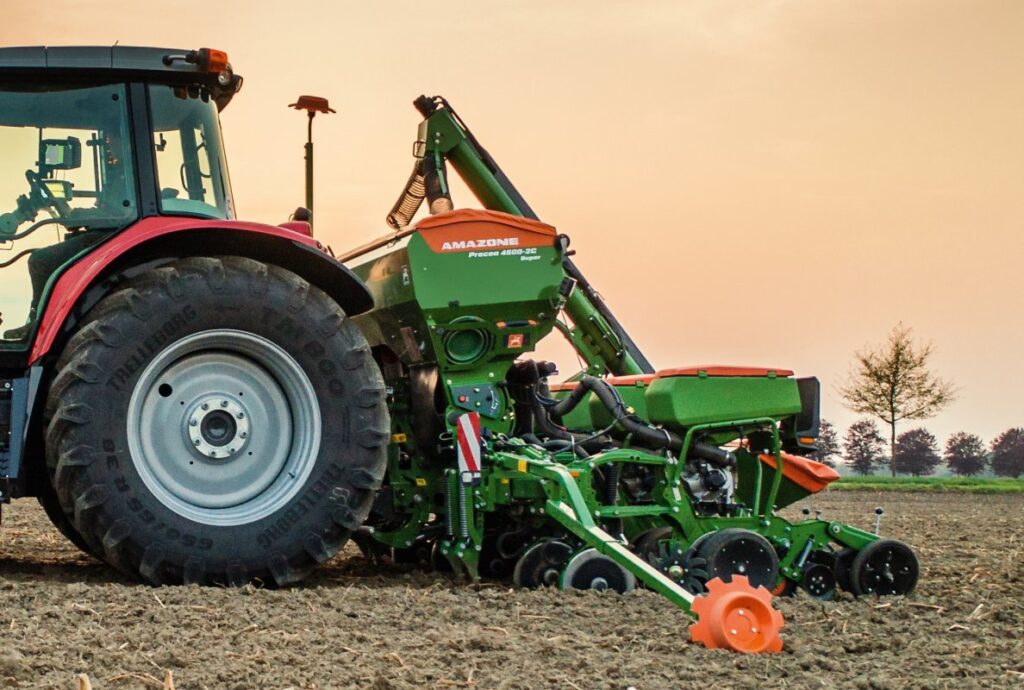
Spot-accurate fertiliser application: Higher yields, save costs, protect the environment
Current precision seeder methods often use a separate coulter to dispense fertiliser alongside the seed. For this purpose, a strip of fertiliser is deposited in a laterally offset position, slightly below the seed. The traditional under-root fertilisation, via this DoubleShoot method guarantees the plant a very good supply of nutrients during its early development. However, this method does not allow the plant to take up and use the fertiliser completely. The reason is that a complete fertiliser strip is placed under the seed row, even where the precision seeder did not place any seeds. The distance from grain to grain within the row when maize sowing, with 75 cm row spacing and 80,000 grains/ha is slightly less than 16 cm. If the theoretical row spacing is 37.5 cm, the distance within the row actually increases to slightly less than 32 cm. The fertiliser between the plants cannot be taken up by them in an optimum way, since the roots do not reach these areas until later on. Part of the nutrients could have been washed away before the plants become able to absorb the fertiliser in the intermediate areas.
However, tightening legal regulations mean that the available fertiliser will need to be used more efficiently in future. Amazone has therefore introduced the new Precea precision seeding technology and the FertiSpot project for pinpoint fertiliser application during single grain seeding. In this process, the fertiliser is not placed in the form of a complete strip below the seed row, but is applied with pinpoint accuracy to the places where the seeds are.
Structure of the FertiSpot system with granular fertiliser
The Precea precision air seeder, with FertiSpot for granular fertiliser, has a fertiliser hopper with fertiliser metering just like the traditional precision air seeder. The fertiliser metering regulates the desired application rate per hectare. This can be varied using application maps. The mineral fertiliser is transferred from the fertiliser metering system to the FertiSpot fertiliser portioning unit. The fertiliser flow, which continuously enters the scoop, is pushed together by a high-speed dosing finger and leaves the unit as a portion and is delivered as a portion to the fertiliser coulter. To ensure that the fertiliser portion is placed exactly under the seed, the metering finger is synchronised with the driving speed and the seed rate by the electronics. The special construction permits all application rates and is compatible with high driving speeds, irrespective of the fertiliser type.
Better utilisation of the fertiliser by the plant
Targeted placement of the fertiliser in the area of the seed grain leads to clearly improved nutrient utilisation, since the availability to the plant increases. Higher availability allows for a reduction in the total amount fertiliser applied per hectare. Initial investigations by the Technical University of Cologne predicted fertiliser savings of 25 % at a similar yield level.
In addition to the positive effects on environmental protection, there are further advantages for operational and work management. Direct cost savings from the reduced amounts of fertiliser required per hectare are accompanied by additional savings due to the higher output levels while sowing, since refill interruptions are reduced by 25 %. In regions with large animal stock levels, mineral fertiliser usage can be saved and the farm manure can be put to more effective use.
Source: Amazonen-Werke H. Dreyer


 Copyright 2017-2025 All rights reserved.
Copyright 2017-2025 All rights reserved.